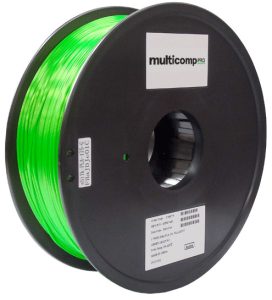“As interest and demand in 3D printing continues to grow, we are happy to provide our customers with a diversified line-up of 3D printer filaments that are designed to meet the quality standards engineers require,” added company product manager Steve Jagger-Marsh.
The materials are:
- PLA (polylactic acid), a vegetable-based polymer that is easy to print and rigid. Suited to objects used below 50°, good for prototypes.
- ABS, a tougher polymer that can withstand higher temperatures than PLA. Good for finished objects, but see ASA for outdoor applications.
- TPU (thermoplastic polyurethane, a TPE), a flexible rubber-like abrasion-resistant plastic (Shore hardness 95A in this case), useful for impact-absorption, soft-touch surfaces, seals, bushing and vibration dampers.
- PVA, a water-soluble material that can be used to print wash-away supports for objects printed in other materials.
- PETG, almost as easy to print as PLA, and almost as impact and heat resistant as ABS. Used for finished objects and tough prototypes.
- PA (polyamide/nylon), semi-flexible, very tough and durable for bearings, structural components and connectors.
- HIPS (high-impact polystyrene) is limonene-soluble and used to support ABS, as well as printing lightweight objects.
- TPE (thermoplastic elastomer), more elastic than the TPU above in this case (Shore hardness 83A), highly durable and fatigue-resistant, and works across -30 to 140°C.
- ASA, which is an ultra-violet-resistant alternative to ABS that is almost as impact and heat resistant. Suited to outdoor applications and less smelly to print.

